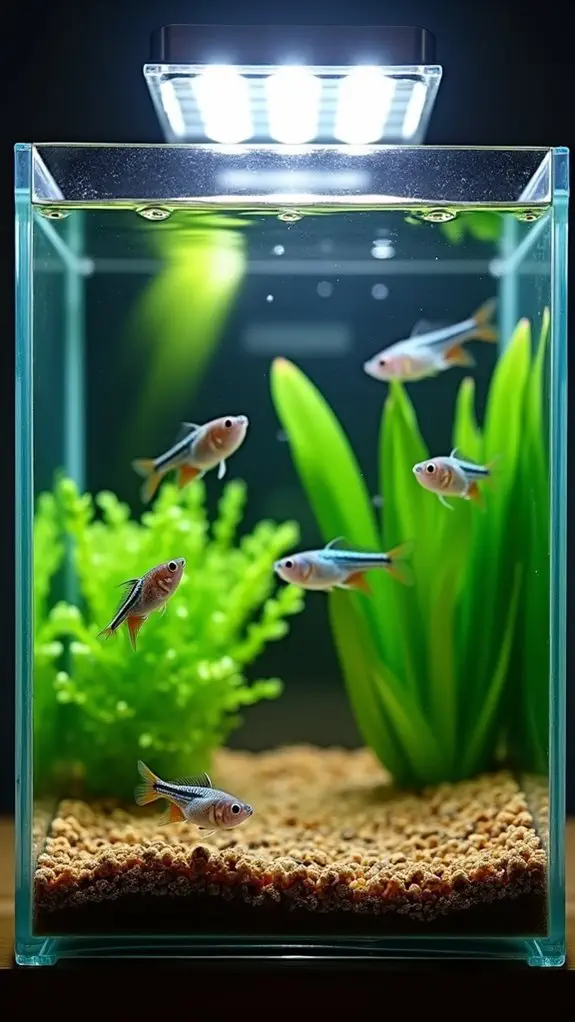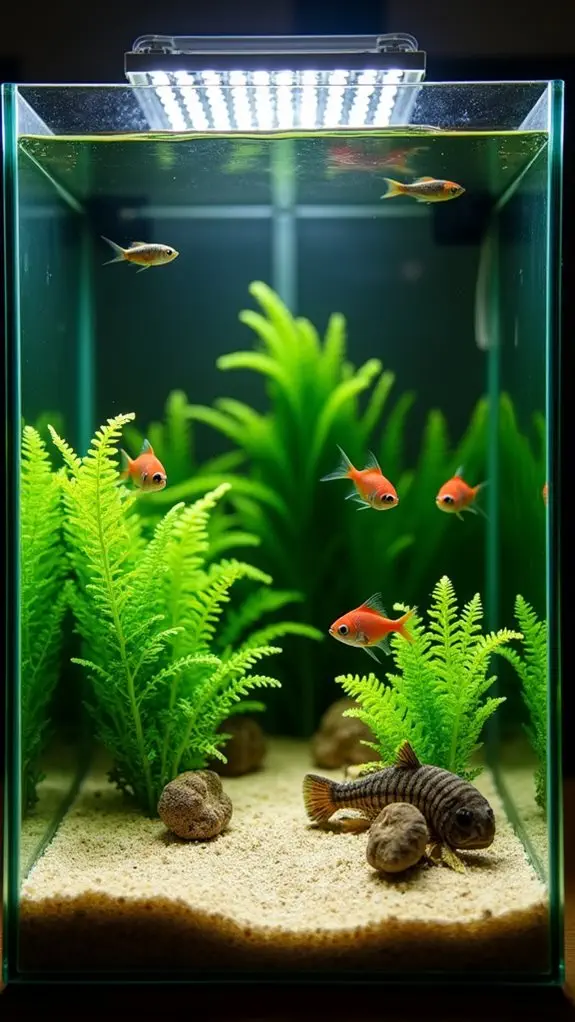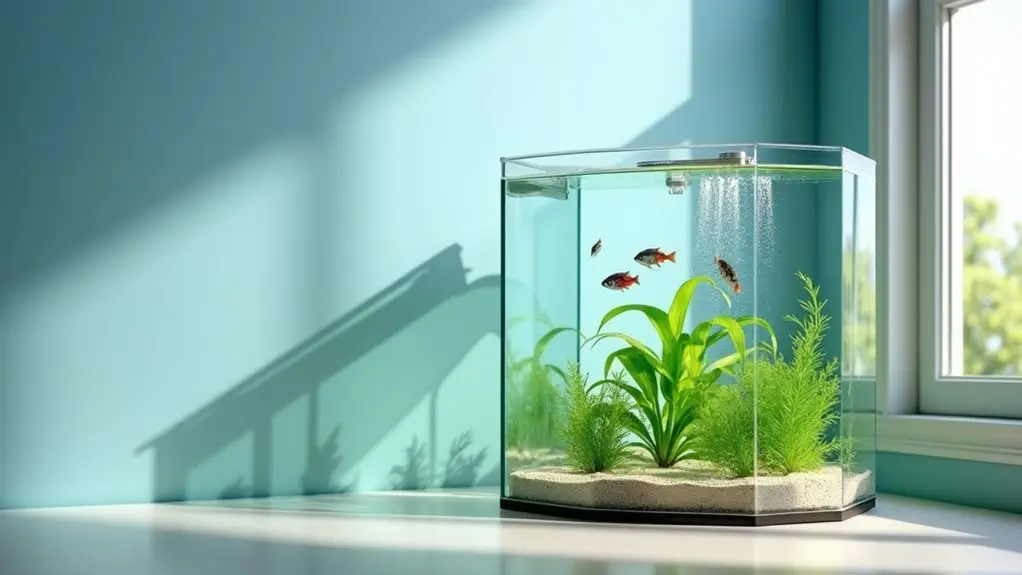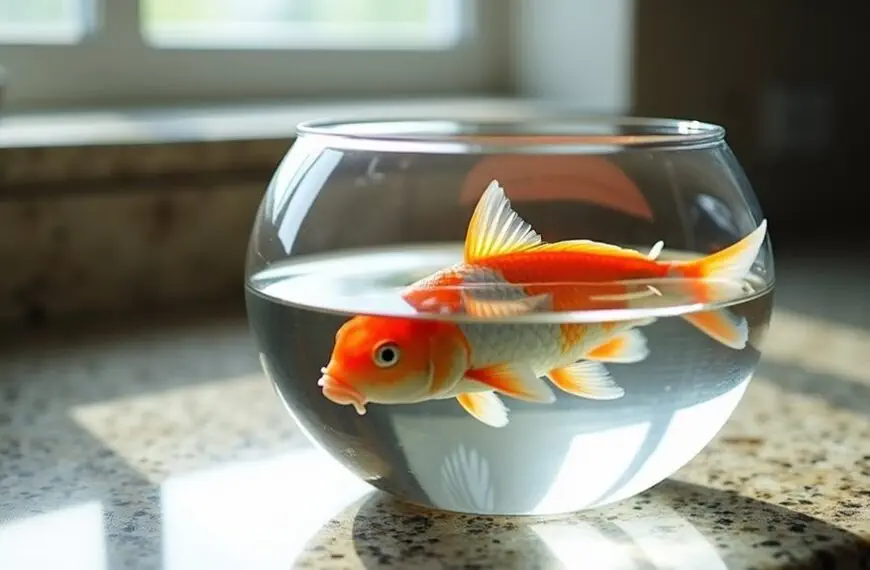As a beginner aquarist, you'll want to start small and build up gradually. For a typical 10-20 gallon tank, begin with just 2-3 hardy fish like Danios or Tetras after your tank has properly cycled (about 4-6 weeks). Following the general "one inch per gallon" rule can help, but don't rush to fill your tank. Add small groups every few weeks while monitoring water quality and fish behavior. Remember that schooling fish need at least 5-6 companions to thrive, so plan accordingly. With proper research and patience, you'll discover the perfect balance for your underwater community.
Contents
- 1 Understanding Tank Capacity Basics
- 2 The One Inch Rule Explained
- 3 Starting With Hardy Fish Species
- 4 Common Beginner Stocking Mistakes
- 5 Essential Water Parameters
- 6 First Month Stocking Guide
- 7 Best Fish For Small Tanks
- 8 Maintaining Healthy Fish Numbers
- 9 Signs of Tank Overcrowding
- 10 Proper Fish Community Planning
- 11 Frequently Asked Questions
- 12 Final Thoughts
Understanding Tank Capacity Basics

A successful aquarium journey begins with understanding tank capacity. When you're starting out, it's important to recognize that bigger isn't always better – but smaller isn't easier either! Using clear bullet points helps organize essential tank size information effectively.
You'll want to evaluate tank dimensions carefully, as they'll directly impact your fish's happiness and your maintenance routine. For beginners, a 10-20 gallon tank offers an ideal sweet spot. It's large enough to maintain stable water conditions yet small enough to manage comfortably. Regular water testing is essential for monitoring your aquarium's health and ensuring water quality management.
When assessing fish compatibility, remember that your tank's size will determine how many fishy friends can coexist peacefully. A good rule of thumb: start with fewer fish than you think you need – you can always add more later!
Your tank's capacity isn't just about water volume; it's about creating a balanced ecosystem. Think of it like a tiny underwater city – every resident needs their space!
While a 5-gallon tank might look cute on your desk, it's actually trickier to maintain than a 20-gallon setup. Evaluate factors like filtration, substrate, and gas exchange when planning your aquatic community.
The One Inch Rule Explained
When setting up your aquarium, you'll often hear about the "one inch per gallon" rule – a popular guideline that suggests you can keep one inch of fish for every gallon of water.
While this rule gives you a starting point, it's not as simple as it seems, and understanding its limitations will help you create a healthier environment for your finned friends.
The one inch rule doesn't tell the whole story because it overlooks important factors like fish behavior and body shape. Alternative methods like X² gallons of water can provide more accurate stocking calculations. Additionally, you should consider the optimal temperature ranges for the species you keep, as this can greatly impact their well-being.
For example, a chubby goldfish needs more space than a slender tetra of the same length. You'll also need to take into account that your tiny new fish will grow – that adorable baby Oscar won't stay small forever! Your filter should process four times the tank's volume per hour for optimal fish health.
Think of it like buying kids' clothes – you always size up.
For better stocking guidelines, focus on your tank's surface area and filtration capacity.
A good rule of thumb is allowing one inch of fish per 12 square inches of surface area for slim fish, and doubling that for bigger-bodied species.
Remember to introduce your fish gradually – your tank's bacteria need time to catch up with the new residents! Regularly testing your water parameters will also help keep your aquarium ecosystem balanced.
Starting With Hardy Fish Species

When you're ready to start stocking your first aquarium, you'll want to begin with small schooling fish like Danios and Tetras, which are perfect for beginners because they're hardy and adaptable. Testing water parameters regularly is essential, and you should ensure nitrate levels stay below 40 ppm. Maintaining optimal water temperature between 74-82°F is crucial for their health. These active swimmers will bring life to your tank while being forgiving of minor beginner mistakes, and they'll show their best colors and behaviors when kept in groups of six or more. Starting with 1-3 fish allows new aquarists to learn proper care techniques before expanding their collection.
For added interest in your aquatic community, consider adding some low-maintenance bottom dwellers like Cory Catfish, which will help keep your tank clean while providing entertainment with their playful personalities.
Small Schooling Fish First
Starting your aquarium journey with small schooling fish offers an excellent introduction to fishkeeping, particularly when you choose hardy species.
You'll want to focus on resilient fish that can handle the learning curve of beginner aquariums, while still creating an engaging display in your tank.
Rasboras and Zebra Danios are fantastic choices to begin with, as they're both hardy and active swimmers that'll bring your aquarium to life. A minimum school of 5 is recommended for Zebra Danios to maintain their natural social behavior. Consider adding Neon Tetras to your tank, as they are low maintenance and thrive well in community setups.
You'll need to keep them in groups of at least 6-10 fish, which helps them feel secure and show off their natural behaviors.
Remember, though, that more fish means you'll need a bigger tank – for instance, you'll want at least 15 gallons for species like Harlequin Rasboras.
When you're setting up your tank, don't rush to add too many fish at once.
Start with a small school and gradually increase the numbers while monitoring your water quality.
It's better to have fewer fish in a well-maintained tank than to overcrowd and stress your underwater friends.
Plus, watching a smaller school of healthy, active fish is much more enjoyable than dealing with stressed ones in an overcrowded tank.
Danios and Tetras Basics
Both danios and tetras rank among the most reliable choices for beginner aquarists, offering a perfect blend of hardiness and visual appeal.
With a typical 3-5 year lifespan, danios make an excellent long-term investment for your aquarium hobby. You'll find danios behavior particularly fascinating, as they're active swimmers that love to zip around the upper levels of your tank. They'll need at least 10 gallons of space and should be kept in groups of four or more to feel secure and show their natural behaviors. These fish thrive in well-maintained environments, requiring good filtration to ensure water quality.
Tetras compatibility is remarkably straightforward, making them excellent community fish. They prefer to swim in the middle to lower levels, which means they'll rarely compete with danios for space. Tetras require a minimum of six in their school to exhibit natural behaviors and reduce stress. Keeping a balanced male-to-female ratio helps maintain harmony in the tank.
You'll want to keep tetras in odd-numbered groups – this quirky requirement actually helps prevent pairing and reduces aggression. Both species thrive in temperatures between 72-82°F, though danios can handle slightly cooler water.
When setting up your tank, you don't need to stress too much about decorations – just provide some plants (real or fake), rocks, and driftwood. These fish aren't picky, but they'll appreciate having places to explore and hide when they're feeling shy. Remember, a well-decorated tank isn't just pretty – it helps your fish feel secure and reduces stress.
Low-Maintenance Bottom Dwellers
Deep within your aquarium's lower levels, bottom-dwelling fish serve as nature's cleanup crew while adding fascinating diversity to your tank. When you're starting out, peaceful species like Corydoras catfish make excellent choices, thanks to their outstanding Corydoras compatibility with nearly all community fish.
These charming little cleaners work tirelessly, sifting through substrate for leftover food while keeping your tank's bottom spotless.
If you're looking for something a bit more unique, consider Kuhli loach care – these eel-like bottom dwellers are fascinating to watch and incredibly hardy. Just remember to provide them with plenty of hiding spots and soft substrate to protect their sensitive barbels.
You'll often catch them playing hide-and-seek among plants and driftwood!
For the best results, keep your bottom dwellers in groups (especially Corydoras) and guarantee your tank is at least 30 liters. It's also important to ensure that your tank is well-cycled to establish beneficial bacteria for a healthy environment.
They'll thrive in a well-planted aquarium with regular water changes and a varied diet. Don't forget to mix it up with sinking pellets and frozen foods – these little custodians deserve more than just leftovers!
Common Beginner Stocking Mistakes
When you're excited to start your aquarium, it's tempting to fill your tank with lots of fish right away, but this common mistake can spell trouble for your new underwater friends.
You'll want to take time researching each species' needs, including their adult size, temperament, and social requirements, since not all fish play nicely together. Remember that some fish need to live in groups or pairs, while others prefer their own space, so planning your tank's population carefully will help create a peaceful and healthy aquatic community. Additionally, ensuring proper tank compatibility and social dynamics is vital for maintaining a harmonious environment in your aquarium.
Too Many Fish Fast
One of the most common mistakes new aquarists make is adding too many fish too quickly to their tanks. While it's exciting to fill your aquarium with colorful swimmers, rushing this process can lead to serious overstocking consequences that'll affect your fish health.
When you add too many fish at once, the tank's beneficial bacteria can't keep up with the sudden increase in waste production. Think of your tank like a new apartment building – you wouldn't want all the tenants moving in on the same day, overwhelming the building's facilities!
Your filter needs time to build up enough beneficial bacteria to handle each new fish's waste. If you add fish too quickly, you'll see ammonia and nitrite levels spike, which can be toxic to your aquatic friends. You might notice your fish gasping at the surface, showing signs of stress, or becoming more aggressive with each other. Additionally, skipping proper water parameter monitoring during this process can lead to even more critical issues.
Instead, add just a few fish every couple of weeks. This gradual approach gives your filtration system time to adjust and guarantees your fish will have plenty of space to thrive.
Improper Species Research
Proper research stands as the foundation of successful fishkeeping, yet many beginners skip this essential step when selecting their aquatic pets. You'll find that diving into a fish purchase without understanding species compatibility and dietary requirements often leads to costly mistakes and stressed-out fish.
Before adding any fish to your tank, you'll want to learn about their adult size, temperament, and specific needs. For instance, that cute little oscar at the pet store will grow into a foot-long giant that needs at least a 50-gallon tank.
Similarly, that peaceful-looking betta might turn into a fin-nipping nightmare if housed with flashy tankmates.
Don't forget to take into account your fish's menu preferences, too! Some species need specialized diets that you can't meet with basic flake food alone.
Taking time to research environmental requirements is equally important – what works for a tropical fish won't suit a coldwater species. Additionally, understanding community tank needs can help ensure that your fish coexist peacefully and thrive together.
Think of it like being a matchmaker: you're not just picking pretty fish; you're creating a compatible community where everyone gets along and thrives in their new home.
Neglecting Fish Social Needs
Along with proper tank setup, understanding fish social needs stands as a critical yet often overlooked aspect of fishkeeping. You wouldn't want to live in a cramped apartment with incompatible roommates, and neither do your fish! Each species has its unique social hierarchy and territorial behavior that you'll need to take into account before adding them to your community tank.
When you're planning your aquarium, you'll want to reflect on how different fish use various swimming levels. Some fish, like bettas, love hanging out near the surface, while others prefer the middle or bottom of the tank. It's like creating a multi-story living space where everyone has their own comfort zone.
You'll also need to guarantee schooling fish have enough buddies – they're social creatures who get stressed when kept alone or in small groups. For example, rasboras thrive in groups of six or more to feel secure and exhibit their vibrant colors.
Don't forget to provide plenty of hiding spots using plants and decorations. These create natural territories and help reduce stress when fish need a quick retreat.
Essential Water Parameters

Maintaining the right water parameters serves as the foundation for a healthy aquarium, whether you're setting up a freshwater or saltwater tank.
You'll need to monitor several key aspects of water quality through regular testing frequency to guarantee your fish thrive in their environment.
For freshwater tanks, you'll want to keep your pH between 5.5 and 7.5, while saltwater tanks need a slightly higher range of 7.8 to 8.3.
Think of it like making the perfect cup of coffee – too strong or too weak, and it just won't taste right! Your ammonia levels should always stay below 0.02 ppm, and nitrites should be at zero – there's no wiggle room here.
For nitrates, freshwater tanks can handle 1-5 ppm, while saltwater tanks can go up to 10 ppm.
Temperature control is vital too. Most tropical fish are happiest between 76-83°F, though specific needs vary by species.
Don't forget about water hardness – it's like the mineral content in your drinking water, but for fish! In freshwater tanks, aim for a general hardness of 3-5 dGH, and make sure you're testing these parameters weekly to catch any issues early. Additionally, maintaining stable pH levels is crucial for preventing stress and health complications in tropical fish.
First Month Stocking Guide
Carefully planning your first month of fish stocking can make or break your aquarium's success.
After completing your tank cycling, you'll want to start slow and steady – think of it as a marathon, not a sprint! Begin with just a few hardy fish, ideally 2-3 small ones for a typical 10-gallon setup, and watch how they adapt to their new home.
During week two, you'll want to monitor your water clarity closely before even thinking about adding more fish.
Fish compatibility is essential at this stage, so research which species get along well together.
If everything's looking good by week three, you can add another small group of 2-3 fish, but don't rush it – your tank's ecosystem needs time to adjust.
Best Fish For Small Tanks

Several excellent fish species thrive in small tanks, making them perfect choices for beginning aquarists. When considering fish compatibility, you'll want to focus on peaceful species that won't outgrow their environment or cause stress to their tank mates.
Tank maintenance becomes much easier when you choose the right small fish, as they produce less waste and adapt well to modest spaces.
Here are some fantastic options that'll make your small tank come alive:
- Pygmy Corydoras: These adorable bottom-dwellers only grow to 1 inch and get along with everyone
- Neon Tetras: They're stunning in groups and add a flash of color to your tank
- Celestial Pearl Danios: Perfect for nano tanks and absolutely gorgeous
- Endler's Livebearers: Hardy and active, they're like tiny underwater puppies
- Pygmy Gouramis: These surface-breathing beauties stay under 2 inches
Remember to introduce your fish gradually and maintain proper water parameters.
Start with a small group of one species, like 6-8 neon tetras, and watch how they interact with their environment. Once you're comfortable with your first group, you can consider adding compatible tank mates to create a diverse yet harmonious community.
Maintaining Healthy Fish Numbers
The key to a thriving aquarium lies in keeping the right number of fish for your tank size. You'll want to follow the simple rule of one inch of fish per two gallons of water, which helps prevent overcrowding and keeps your finned friends happy.
Think of it like a tiny underwater neighborhood – nobody likes living in cramped quarters!
When you're planning your aquatic community, it's essential to understand fish behavior and how different species interact. If you've got a 20-gallon tank, you'll do well with a small group of peaceful fish, while a 40-gallon setup gives you more flexibility with both numbers and species.
Remember, though, that more fish means more tank maintenance, so don't bite off more than you can chew!
Keep a close eye on your water quality by testing it every two weeks, especially in smaller tanks. If you notice your fish looking stressed or the water getting cloudy quickly, you might've too many swimmers in there.
It's better to start with fewer fish and add more gradually than to overwhelm your tank from the get-go – your fish will thank you for it!
Signs of Tank Overcrowding

Recognizing signs of overcrowding early can prevent serious problems in your aquarium. When you've got too many fish in your tank, they'll show you through their behavior and the water conditions. Think of it like a crowded elevator – nobody's happy when there's no room to move!
You'll notice several overcrowding symptoms that indicate behavioral stress in your fishy friends. Watch for these key warning signs:
- Fish hiding constantly or lurking in corners
- Aggressive chasing and fin nipping between tank mates
- Fish gasping at the water surface for air
- Cloudy water that gets dirty quickly despite regular cleaning
- Visible waste buildup on the tank bottom
If you're seeing these signs, your tank is probably overcrowded. You'll also notice that your filter's working overtime, and water quality tests show high ammonia levels more frequently than usual.
When fish don't have enough space, they become stressed and more susceptible to disease. It's like living in a tiny apartment with too many roommates – nobody thrives in those conditions!
Proper Fish Community Planning
Successful fish community planning starts with understanding your tank's capacity and your fish's needs. A 20-gallon tank is your best bet as a beginner, as it'll give you more options and stability.
Remember, you'll want to follow the one-inch-per-gallon rule when stocking tropical fish, but don't rush to fill your tank right away!
When you're planning your fish community dynamics, think of your tank as a three-story apartment building. You'll want residents at every level – top, middle, and bottom. Tetras and barbs make great middle-level swimmers, while other species can occupy different zones.
It's like creating a harmonious neighborhood where everyone gets along!
Pay close attention to fish behavior and compatibility. You wouldn't want to put a peaceful gourami with fin-nipping tiger barbs – that's like inviting a vegetarian to a steakhouse!
Start small with just 6-9 fish in a 20-40 gallon tank, allowing your filtration system to establish itself.
Consider whether you'll use fishless or fish-in cycling methods, as both require different levels of commitment and patience.
Frequently Asked Questions
How Long Should I Wait Between Adding Different Groups of Fish?
You'll need to wait 2-3 weeks between adding different fish groups. This allows the cycling process to stabilize and guarantees tank stability. Monitor your water parameters closely during this time to prevent issues.
Can I Mix Tropical Fish With Goldfish in My First Tank?
No, you shouldn't mix tropical fish with goldfish due to poor tank compatibility. They require different temperatures and have conflicting fish behavior patterns. This combination can lead to stress, illness, and aggression.
Should I Buy All My Fish From the Same Pet Store?
You'll benefit from a reputable local store's consistent quality and support. While specialty fish stores offer unique options, it's smart to stick with one trusted source, though you can explore online shopping for variety.
What Happens if One of My First Fish Dies Unexpectedly?
If you lose a fish unexpectedly, don't add new fish immediately. First, test your water quality and review your fish care routine. Perform proper tank maintenance to guarantee conditions are stable before introducing replacements.
Do I Need to Quarantine New Fish Before Adding Them?
Yes, you'll want to quarantine new fish for 4-6 weeks in a separate tank before adding them to your main aquarium. This quarantine method helps with disease prevention and protects your existing fish.
Final Thoughts
As you start your fishkeeping journey, you'll find that it's better to begin with fewer fish than too many. Start with 3-5 hardy fish in a properly cycled tank, and you'll set yourself up for success. Remember, you can always add more fish gradually as you gain experience. Just keep monitoring those water parameters, watch for signs of overcrowding, and you'll be well on your way to maintaining a thriving aquatic community.












